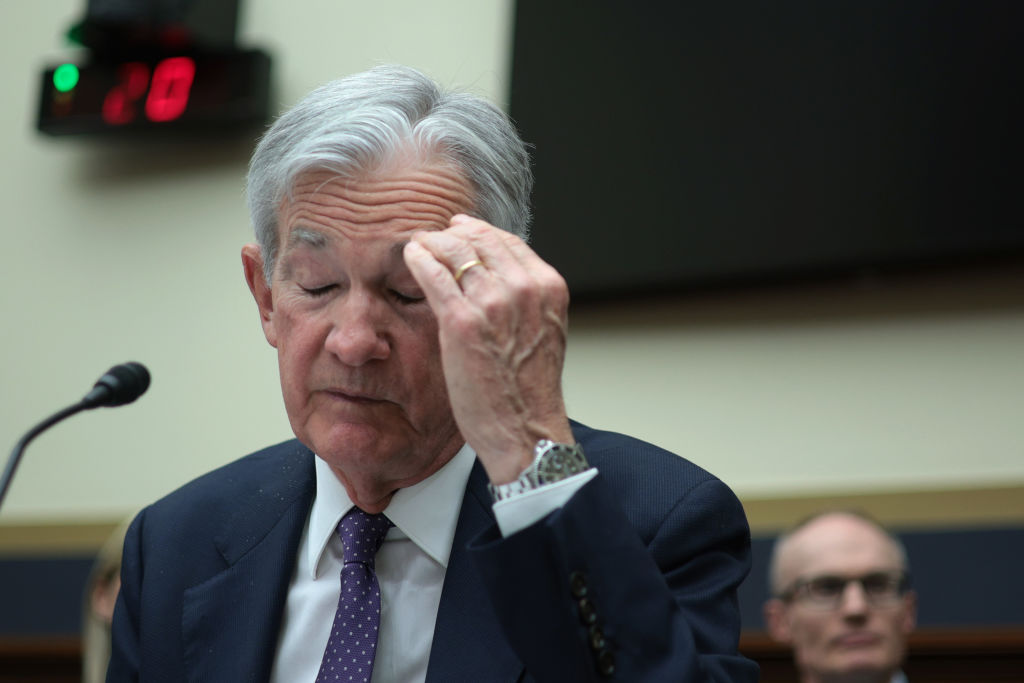What's going on with the gold price?
Stocks and bonds are going down at the same time. The dollar has bounced despite some very dodgy fundamentals. And 'safe haven' gold sank to a two-week low last week. Adrian Ash unravels some decidedly odd market conditions.
It's acold and bitter truththat the world's investment markets rarely act as sober as Britney Spears in a new wig.
In fact, as John Maynard Keynes famously noted, they're prone to stay much crazier for much longer than a right-minded investor can stay solvent.
But is that really an excuse for the world's financial markets acting so tired and emotional right now?
MoneyWeek
Subscribe to MoneyWeek today and get your first six magazine issues absolutely FREE

Sign up to Money Morning
Don't miss the latest investment and personal finances news, market analysis, plus money-saving tips with our free twice-daily newsletter
Don't miss the latest investment and personal finances news, market analysis, plus money-saving tips with our free twice-daily newsletter
US Treasury bonds this week delivered their worst drop in more than three years, but global stock markets also plunged defying the base logic that bonds rise when stocks fall, as investors flee the risk of lower earnings for the safety of fixed income.
The Western world's five biggest central banks meantime pledged $100bn in loans to help inter-bank lending, but short-term interest rates barely flickered. 'It's not going to help us find an exit to this crisis,' warned Cyril Beuzit at BNP Paribas in London. 'Banks are still reluctant to lend money to each other because there are serious concerns about potential further bad news.'
The Dollar then bounced on surging inflation data, even after the Federal Reserve cut US interest rates to stimulate fresh money creation. Grain, soybean and oil prices all rose too, despite analysts the world over forecasting a global slowdown.
And Gold Prices? Well, gold gave back all of its gains from Monday, and sank to a series of two-week lows for British and European investors, even though rising inflation and lower interest rates are the very conditions that tend to drive investors into the Gold Market if only when they finally have a moment of clarity and quit drinking at their Bloomberg terminals.
'Gold down as Dollar strengthens,' said a headline late Thursday, 'lower oil prices reduce inflation risk.' Which all sounds fair enough, until you cock an ear to the deafening thunder now rolling above Wall Street's very heads.
Most investors and not least the big institutional managers would rather try to drown it out by replaying the newswires' sound and fury on their new iPhones.
But when stocks and bonds all slip together...sliding alongside house prices and the huge credit-derivative markets they now underpin...not even that pair of Bose Quiet Comfort 2's you asked Santa to get you for Christmas is going to cancel this noise.
Hark at the Dollar's bounce, for example...
Turning tail from its worst valuation ever on the world's currency markets, the US Dollar has now gained more than 3% since the start of November.
The fundamentals, however, are going about as well as Lindsay Lohan's post-rehab recovery if Star magazine is to be believed.
Believed about Lindsay, that is. The Dollar's holed up in a hotel shooting neat vodka for sure, whatever its 'people' are telling the press...
- US interest rates have been cut by 0.5% since Halloween;
- The number of home-buyers now one month or more behind with their mortgage payments rose by one-third in the third quarter alone, says RealtyTrac;
-Consumer Price Inflation even on the official measure just broke 4.3%, way ahead of even the gloomiest Wall Street forecasts;
-The trade deficit refuses to shrink, despite the shrinking Dollar.
Trouble is, not least for US investors wanting to use this bounce in the greenback to switch overseas, the same deafening thunder is rolling across pretty much everywhere else right now, too.
Germany's consumer-price inflation broke 3.1% year-on-year in November. Europe-wide, the cost of living rose 0.5% last month alone from October. In the United Kingdom, the CPI looks a little tamer. But the older and more trustworthy Retail Price measure rose to 4.2%, even as the UK's 10-year housing boom continued to plunge from the top of this summer.
Meantime in the oil pits, 'I think we are going to give back a lot of what we gained Wednesday, if not today at least during the next week,' reckoned Phil Flynn, senior trader at Alaron Trading in Chicago, to Bloomberg on Thursday.
'The [oil] bulls need to be fed every day and I don't see the Fed adding yet more liquidity to the market today.'
Oh really? The New York Fed injected $20.75 billion in short-term funds into the money market on Thursday, more than one-quarter of it in two-week loans.
But hey the average daily injection in November was $45.95bn. So on a relative basis, and what with Christmas coming...good will to all men, and all that...then sure. The Fed's doing its damnedest to support the Dollar, keep a lid on oil prices, and ward off inflation with a magic wand marked 'tight money'.
'Nor are the numbers devastating in the bond markets,' says George Friedman of Stratfor, puzzling over the on-going crisis in world money markets. It led to Wednesday's joint action by five of the world's largest central banks, but the interbank lending rate in London center of the world for short-term finance didn't budge.
'By definition, a liquidity crisis occurs when the money supply is too tight and demand is too great,' says Friedman. 'In other words, a liquidity crisis would be reflected in high interest rates. That hasn't happened.
'In fact, both short-term and, particularly, long-term interest rates have trended downward over the past weeks. It might be said that interest rates are low, but that lenders won't lend. If so, that is sectoral and short-term at most. Low interest rates and no liquidity is an oxymoron.'
All told, in short, the Western world's central bankers and by extension, the poor mugs who have to get by on the paper money they're supposed to look after now face a big, ugly challenge, almost as angry as the pitbull chewing a wasp that Timothy Geithner, president of the New York Fed, waved a stick at during a speech to Princeton University this week:
'Do we need additional instruments that would better enable us to mitigate marketwide liquidity problems?' he asked. 'And how can we mitigate the moral hazard risk inherent in such instruments?'
Note the lack of a conditional in Geithner's second sentence. Gabbing 'can' rather than 'could', he clearly believes the answer to Question #1 is 'yes' a loud, happy kind of yes, usually barked by consenting adults drunk together in a Vegas motel room. With a couple of friends along to watch.
If we were in the business of making short-term calls in the Gold Market here at BullionVault (which we're not), we'd wager that gold below $800 per ounce will be all but a happy memory sometime soon in 2008.
When things don't stack up and when the markets get as crazy and mixed-up as they are now someone's sure to get hurt or lose an eye. Our guess, for what it's worth, is that it won't be gold owners, not if they buy gold for defense against the ailing Dollar, rising inflation, slowing growth and on-going crunch in world money markets.
But we could be wrong. Right?
Adrian Ash is editor of Gold News and head of research at www.bullionvault.com
Get the latest financial news, insights and expert analysis from our award-winning MoneyWeek team, to help you understand what really matters when it comes to your finances.
Adrian has written all things gold related from if it’s worth buying, what the real price of gold should be and what’s the point of gold for MoneyWeek. He has also written for other leading money titles on his gold expertise including Business Insider, Forbes, City A.M, Yahoo Finance and What Investment Magazine. Now Adrian is head of the research desk at BullionVault, a physical market for gold and silver for private investors online.
-
 Investors will reap long-term rewards from UK equities
Investors will reap long-term rewards from UK equitiesOpinion Nick Train, portfolio manager, Finsbury Growth & Income Trust, highlights three UK equities where he’d put his money
-
 The graphene revolution is progressing slowly but surely
The graphene revolution is progressing slowly but surelyEnthusiasts thought the discovery that graphene, a form of carbon, could be extracted from graphite would change the world. They might've been early, not wrong.
-
 The challenge with currency hedging
The challenge with currency hedgingA weaker dollar will make currency hedges more appealing, but volatile rates may complicate the results
-
 Can Donald Trump fire Jay Powell – and what do his threats mean for investors?
Can Donald Trump fire Jay Powell – and what do his threats mean for investors?Donald Trump has been vocal in his criticism of Jerome "Jay" Powell, chairman of the Federal Reserve. What do his threats to fire him mean for markets and investors?
-
 Freetrade’s new easy-access funds aim to beat top savings rates
Freetrade’s new easy-access funds aim to beat top savings ratesFreetrade has launched an easy-access exchange traded fund (ETF) range - here’s how the ETFs work and how they compare to the savings market
-
 Go for value stocks to insure your portfolio against shocks, says James Montier
Go for value stocks to insure your portfolio against shocks, says James MontierInterview James Montier, at investment management group GMO, discusses value stocks and slow-burn Minsky moments with MoneyWeek.
-
 Where do we go from here?
Where do we go from here?Features A new series of interviews from MoneyWeek
-
 As China reopens, why pick an income strategy?
As China reopens, why pick an income strategy?Advertisement Feature Yoojeong Oh, Investment Manager, abrdn Asian Income Fund Limited
-
 Income in the USA
Income in the USAAdvertisement Feature Fran Radano, manager on The North American Income Trust
-
 The challenge of turbulent markets
The challenge of turbulent marketsAdvertisement Feature Today, ISA investors face one of the most challenging economic environments seen in recent years. However, good companies can still thrive, even in the toughest economic conditions. That’s why BlackRock’s fund managers focus on these businesses when they’re looking for investment opportunities.